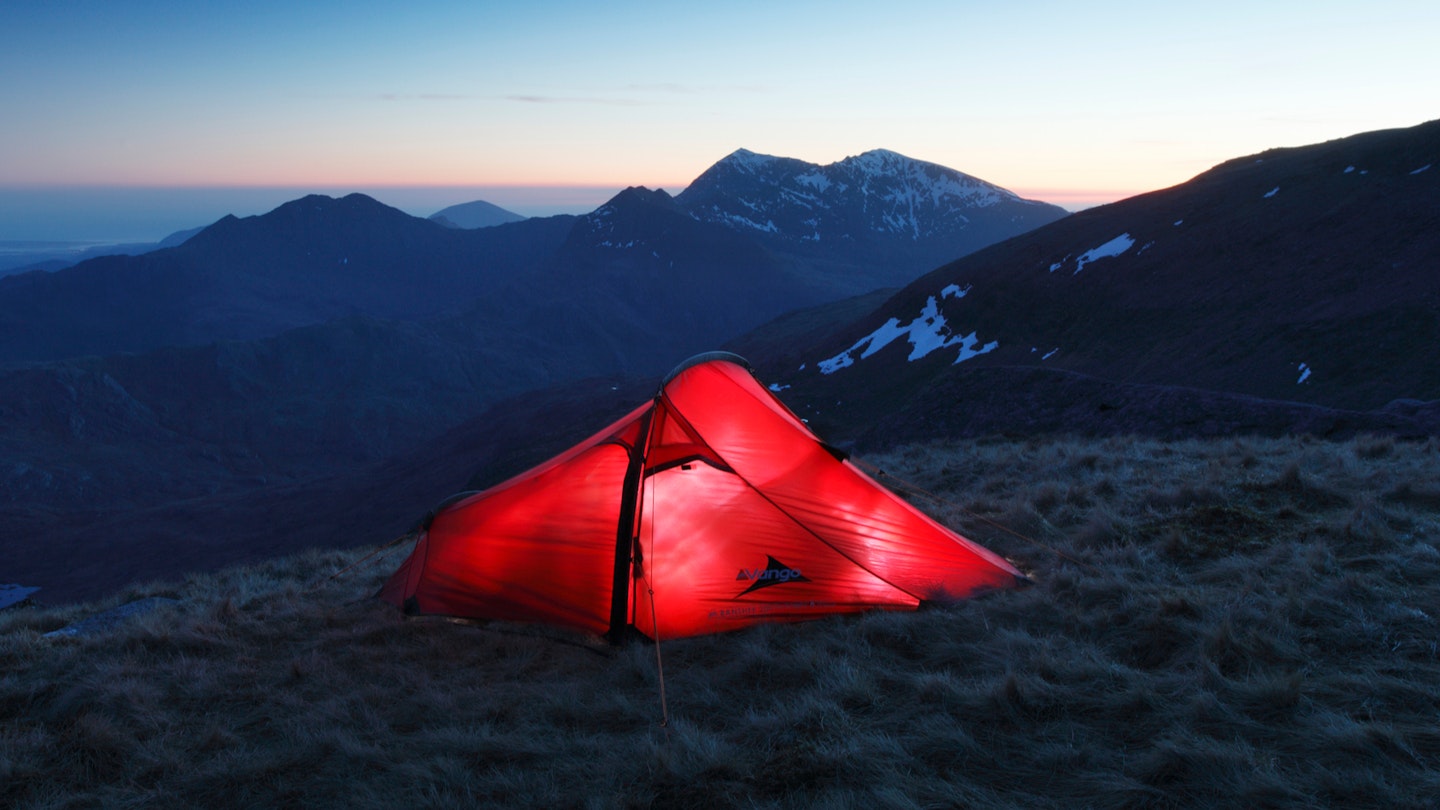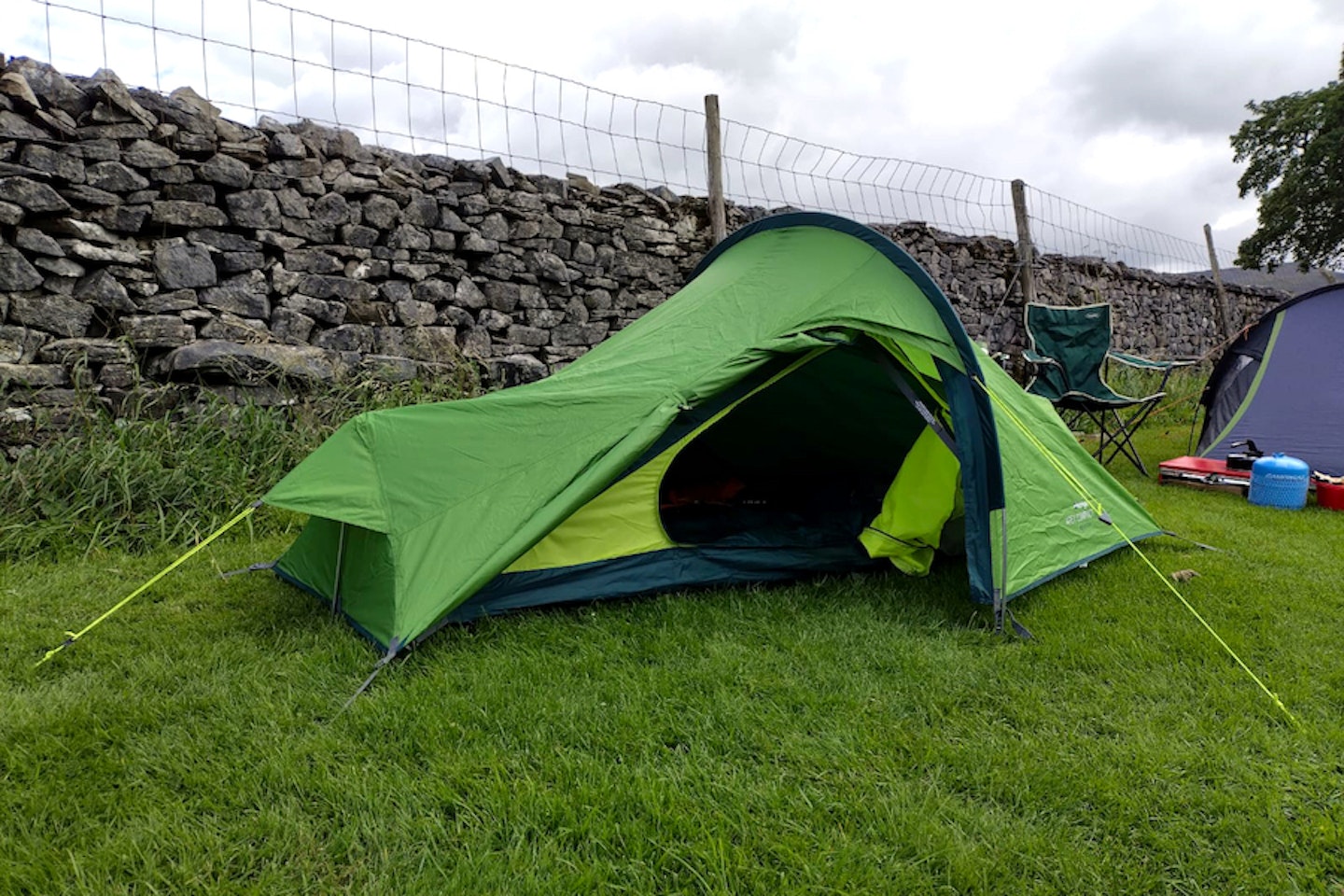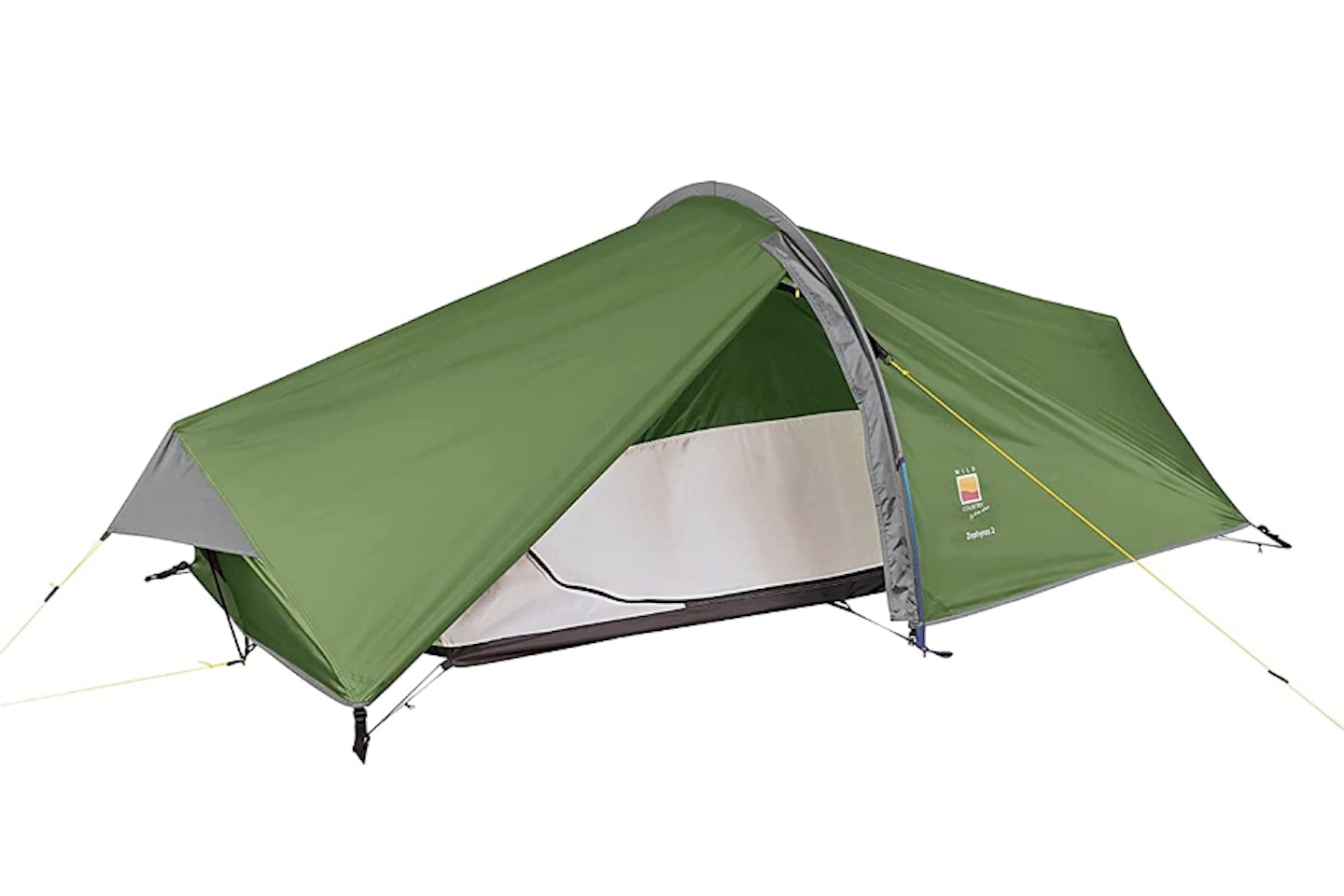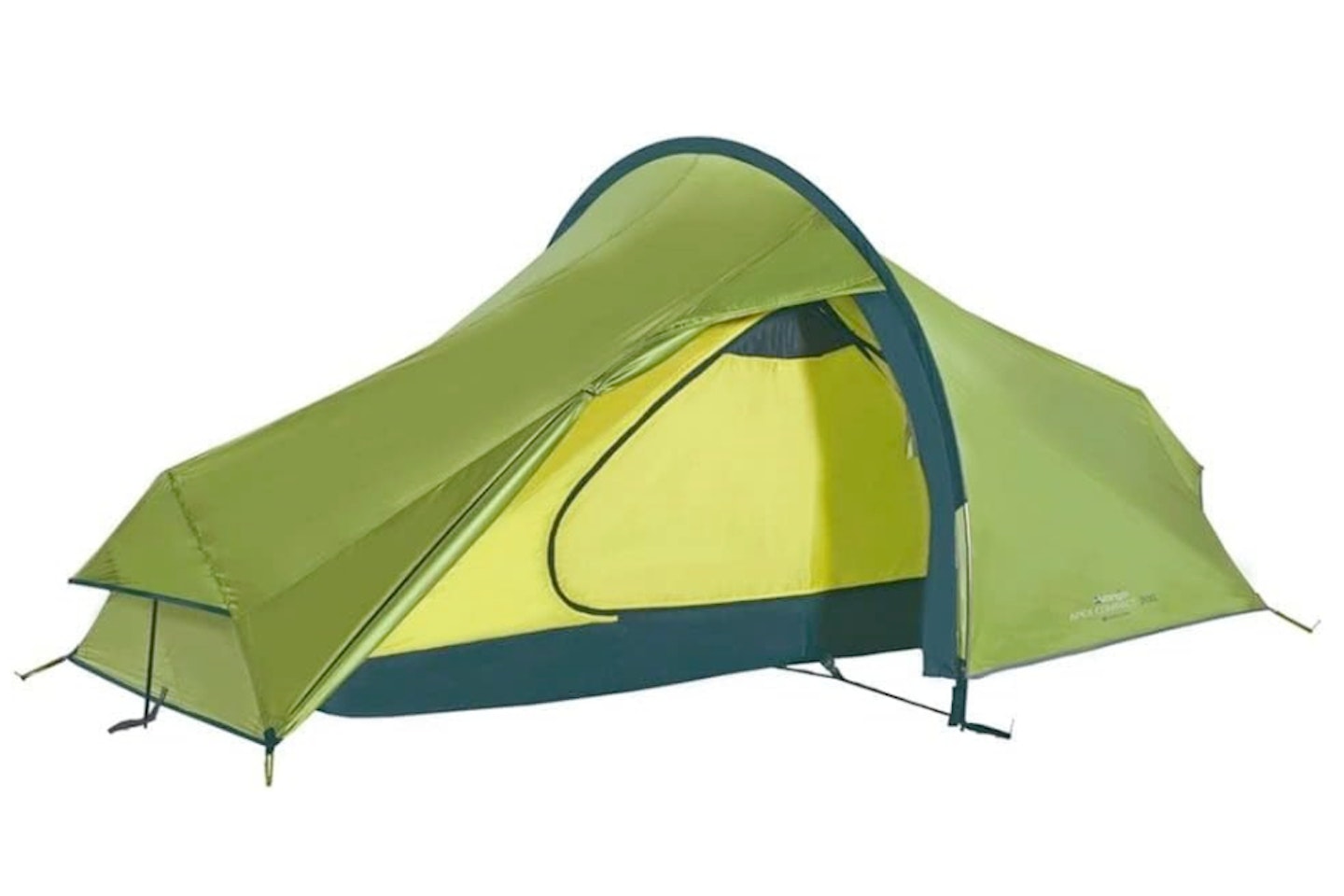Camping offers a stripped-back escape from the modern world and a chance to reconnect with nature. While some people can get all they need from pitching up on a campsite, some want to take things a step further and truly experience an off-grid life. These people go wild camping, so you must ensure they have the best tent for wild camping. Below, we highlight some of the best tents for 2025 wild camping - make you pick and enjoy the great outdoors. Just don't forget to pick up after yourself.
There are many reasons why one might take to wild camping. The UK has long routes and national trails, which can take several weeks to complete - sometimes, wild camping is the only way to get through such routes, spattered with the occasional overnight in a bothy. Others will head out simply for solitude, parking in a remote location and hiking off into the high fells to a secluded spot.
The best tents for wild camping 2025 at a glance:
• Best budget wild camping tent: Vango Apex 100 - View on Amazon
• Best wild camping tent: Robens Elk River 1 - View on Ebay
• Best two-person wild camping tent: Wild Country Zephyros Compact 2 - View on Amazon
The best tents for wild camping are more specialised than standard tents because they must be carried and, depending on your destination, up to handle the worst of weather. Compared with four-person tents, tents suitable for wild camping are small and minimalist - sacrificing comforts like headroom and porches in the name of efficient, compact design.
Below, our outdoor experts have looked into the best tents for wild camping based on their years of knowledge and tried and tested experience, from spending family holidays in six-person tents through to spending weekends exploring with backpacking tents. Though our selection points toward wild camping pursuits, the tents we have selected are also great for other camping excursions. Due to their lightweight and efficient design, they are equally important as backpacking tents or for backpackers, those walking between official campsites, and light and minimalist hikers and campers.
Please note: All prices are correct at the time of writing. Prices, stock and deals are subject to change without notice.
The best tents for wild camping 2025
The Vango Apex 100 is an excellent one-person tent and one of our top picks for the best tent for wild camping. Often found at a price well under its £150 RRP and weighing under 2kg, the Apex 100 is light on your bank account and backpack.
Following the tunnel tent design convention, the Apex offers a good amount of space for its relative size. One of our favourite elements is the porch, which adds some excellent utility, letting you operate with a little more space and protection.
The inner is fitted to the 70D flysheet, meaning pitching is quick and easy. At 3,000HH, it will keep the rain off from a downpour, too. The Apex 100 comes in a small, easy-stow bag for quickly breaking camp. The bag is also designed for bikepacking, meaning it can stow onto handlebars.
This tent gets some bonus points, too - it's made using recycled material, including over 20 water bottles.
Pros
- Affordable without skimping on details
- Lightweight and easy to pitch
- Made from recycled materials
Cons
- The adjustable anchors slip, so best pitched with them at full extenstion
| Total weight: | 1.88kg |
| Pack size: | 30.0 x ø15.0cm |
| Fabric: | Protex Eco |
| HH rating: | 3000mm |
| Capacity: | One person |
| Trail weight: | 1.6kg |
Best tent for wild camping

www.ebay.co.uk
The Robens Elk River 1 Tent is one of the best tents for wild camping because it is lightweight, compact, and ideally suited to solo treks. It's a real winner thanks to its pole design, which forms an exoskeleton which allows you to quickly pitch the tent without exposing the inner to lousy weather.
The tent features a spacious inner sleeping area, offering comfortable sleeping space for one person, while the porch area provides room for gear storage. The durable and weather-resistant materials, including a 5,000mm HH rating on the 30D flysheet, ensure protection against rain and wind. Ventilation is provided through multiple mesh panels, reducing condensation.
The excellence of the Elk River 1 consolidates with the impressive weight - a mere 1.52kg.
Pros
- Excellent pitching
- Sturdy and waterproof
- Good living space
Cons
- Pricey for wild camping newbies
| Total weight: | 1.52 kg |
| Pack size: | 42 x 11 cm |
| Fabric: | <strong>Flysheet:</strong> Hydrotex AWT-T, 30D polyester 350T, Ripstop polyester outside, siliconised PU inside, taped seams. <strong>Inner:</strong> 30D ripstop polyester, breathable polyester |
| HH rating: | 3000mm |
| Capacity: | One person |
| Trail weight: | 1.38 kg |
Best wild camping tent for two
We had a great time testing the Wild Country Zephyros Compact 2. It excels in terms of weight and portability, making it an ideal choice for two-person wild camping, backpacking and hiking trips. It’s constructed with durable materials that withstand various weather conditions, including rain and wind, thanks to the 4000HH.
The tent's design is intuitive and straightforward, allowing for easy setup and takedown. It offers sufficient space for two people, with a vestibule area for storing gear. We must commend the tent's ventilation system here, which helps prevent condensation build-up inside - a much more significant problem when there are two bodies breathing.
While the Zephyros Compact 2 delivers on its promises of lightweight performance and durability, the tent does have limited headroom and floor space that may be a bit restrictive for taller individuals or those with more gear.
Overall, the Wild Country Zephyros Compact 2 is highly recommended for outdoor enthusiasts looking for a lightweight, portable, and reliable tent.
Read our full review of the Zephyros Compact 2.
Pros
- Basic but well-made
- Light and compact
- Easy pitching
Cons
- Small porch
- Not free standing
| Total weight: | 1.95kg |
| Pack size: | 30cm x 19cm |
| Fabric: | Stormtex P4000, Aquastop P5000 groundsheet |
| HH rating: | 4000mm |
| Capacity: | Two people |
| Trail weight: | - |
Best wild camping tent for three
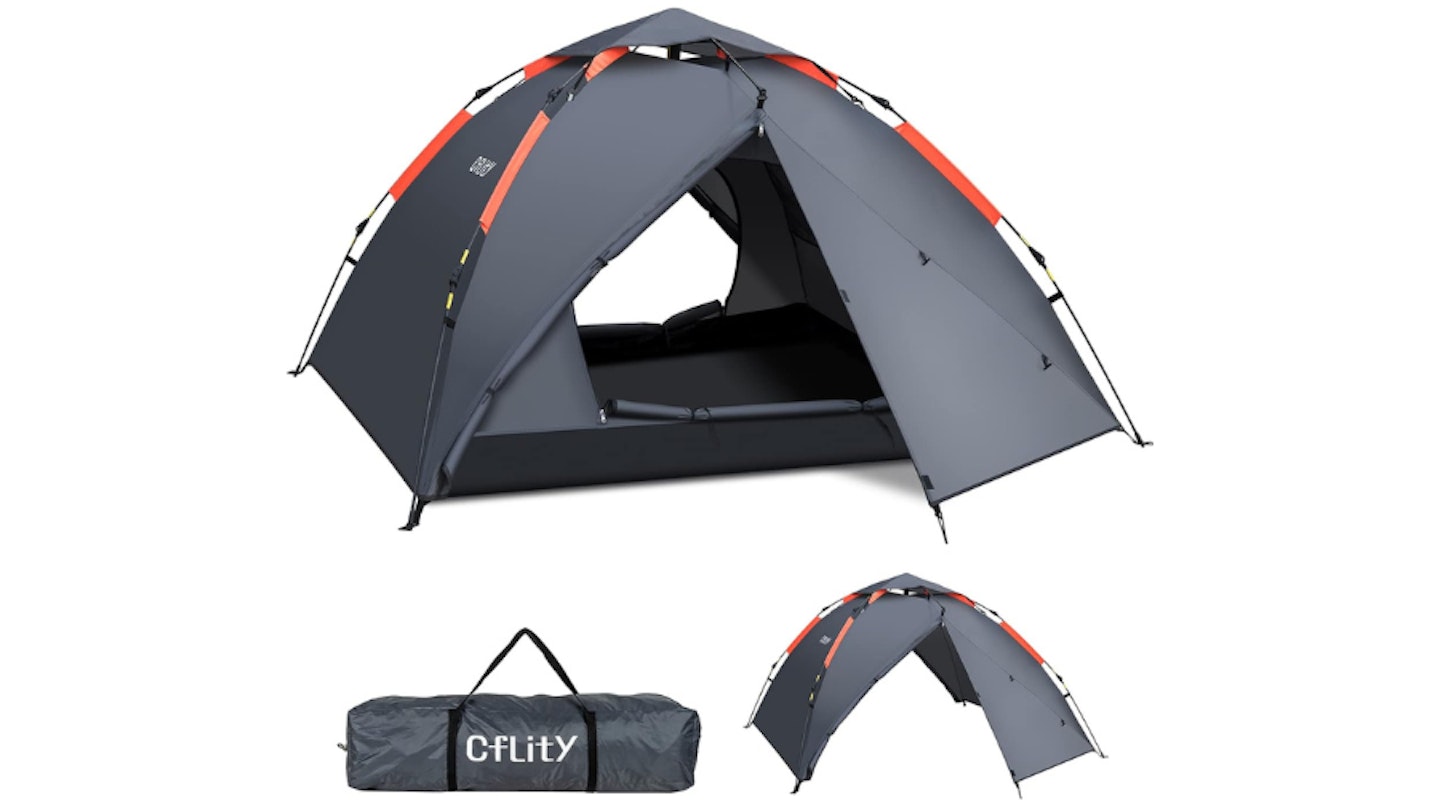 Amazon
AmazonIf you're looking for a tent that marries speed with space, the Cflity Camping Tent is an excellent choice. This 3-man instant pop-up tent sets up in a flash, leaving more time to enjoy the great outdoors. Its spacious interior is perfect for a trio of campers, offering enough room to sleep comfortably and store essential kit.
The Cflity Camping Tent comes in a sleek grey colour, blending well with most outdoor environments while providing a touch of style. It features a high-quality waterproof design and the removable rain-fly is a standout too, offering an extra layer of weather protection that can be detached on clearer nights for stargazing or increased airflow.
Perhaps the most appealing feature is its extensible porch. This additional space is ideal for muddy boots or cooking equipment, keeping the main living area clean and clutter-free. Lightweight yet durable, the Cflity offers a much sought after balance for those seeking adventure without the burden of a heavy setup. Whether you’re embarking on a weekend of hiking or a family camp-out, this tent offers comfort, convenience, and reliability.
Pros
- Brilliant value for money
- Feature-rich and reliable
- Trusty budget 3-man option
Cons
- Doesn't come with any pegs or guy ropes
| Total weight: | 4.08kg |
| Pack size: | 230 x 287 cm |
| Fabric: | Polyester |
| HH rating: | 3000mm |
| Capacity: | Three people |
| Trail weight: | - |
Best bivi for wild camping
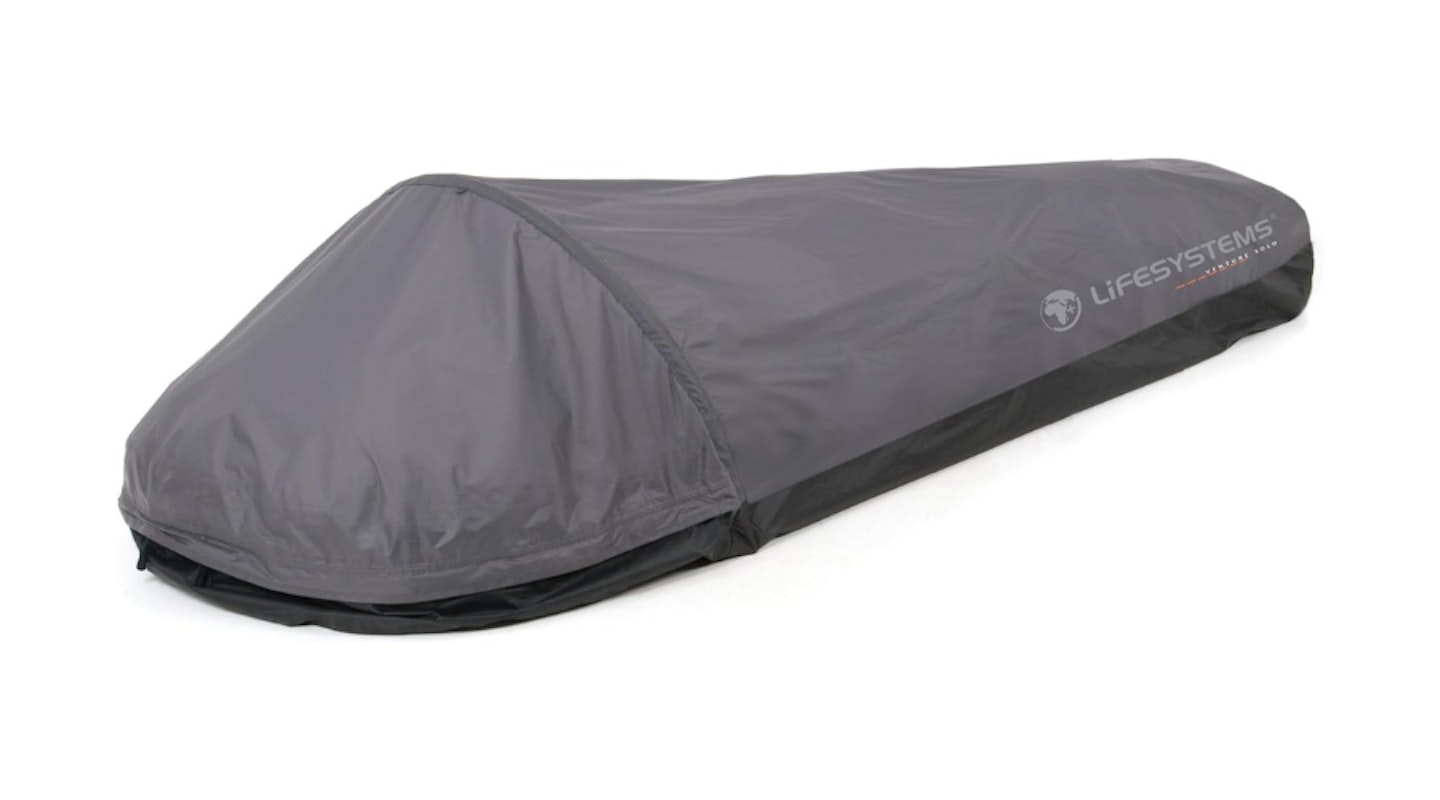 Amazon
AmazonBridging the gap between a sleeping bag and a tent is the bivi. It's a waterproof and breathable sheet that fits a sleeping bag and mat, providing shelter for minimalist camping. And for our money, the Lifesystems Venture is the best option.
The Solo Bivi is incredibly light, weighing only 680g. It comes with a zipped bug-screen, zippered hood and a half-moon foot. It's also got a HH rating of 11,000mm - the highest on this list, so waterproofing is top notch.
The only downside, shared with all bivis, is that your gear is out in the wild and without protection. If your bag is waterproof, or you can hang it from a tree, this is no worry. We'd also recommend keeping your quick-access essentials - toothbrush, phone, toilet paper, headtorch - near your head in a dry bag in case you need it late at night.
Pros
- Ultra lightweight
- Minimalist
- No pitching required
Cons
- Too stripped back for most
| Total weight: | 680g |
| Pack size: | 31 x 11cm |
| Fabric: | Ripstop nylon |
| HH rating: | 11000mm |
| Capacity: | One person |
| Trail weight: | - |
Best trekking pole wild camping tent
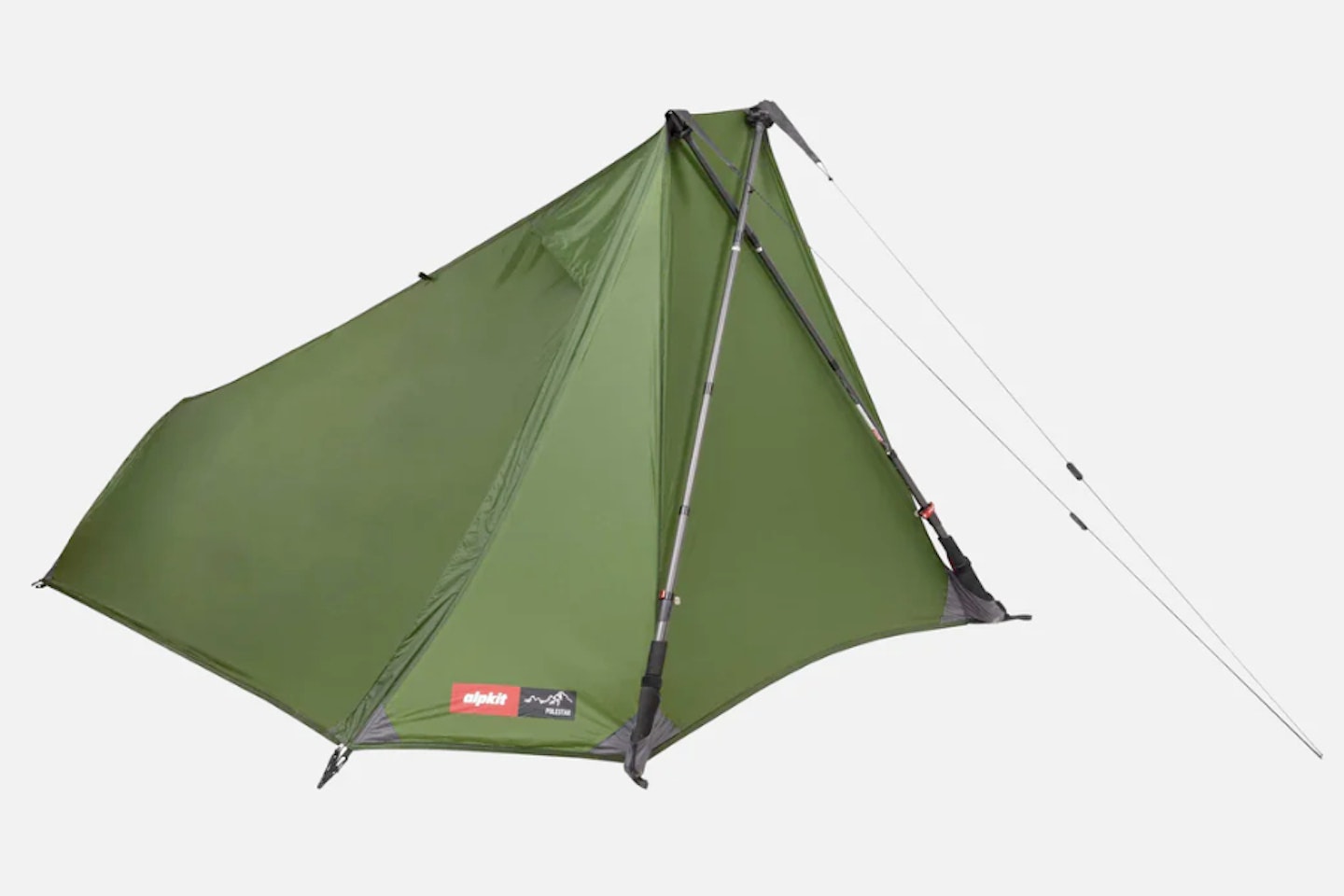
alpkit.com
Regarding gear, backpacking and wild camping are all about efficiency and maximising the use of as many items as possible. With this tent from Alpkit, you can use your walking poles to erect the tent, cutting down on the need to carry dedicated poles as you hike. As a result, you're only adding 980g to your pack.
It's got a 3,000HH on the 20D flysheet and 5,000HH on the groundsheet to protect you from dampness seeping in. At purchase, you can add a groundsheet into the mix, adding the ground protection - just note, this will up the weight carried.
The inner tent has mesh for breathability, though the tent can pitch outer-only to reduce weight and minimise the camping experience.
Pros
- Lightweight
- Maximises gear usage
- Sturdy
Cons
- No good if you don't already use walking poles
| Total weight: | 980g |
| Pack size: | 42cm x 11cm |
| Fabric: | <strong>Flysheet:</strong> 20D silicone coated ripstop polyester with PU backer <strong>Inner:</strong> 20D breathable ripstop nylon <strong>Ground:</strong> 20D ripstop polyester with PU backer |
| HH rating: | 3000mm |
| Capacity: | One person |
| Trail weight: | - |
- "Purchased this wee tent to do great Glen way and Hadrians wall, did not disappoint. Lightweight easy to erect and dismantle and packs down small. Bonus no poles required as uses walking poles. Had a test against the rain and no leakage noted.
Only one problem was condensation on a few mornings but don’t think the air vent was fully opened. Side opening I find easier to get in and out and a porch large enough to store my rucksack."
Best tent for wild camping in bad weather
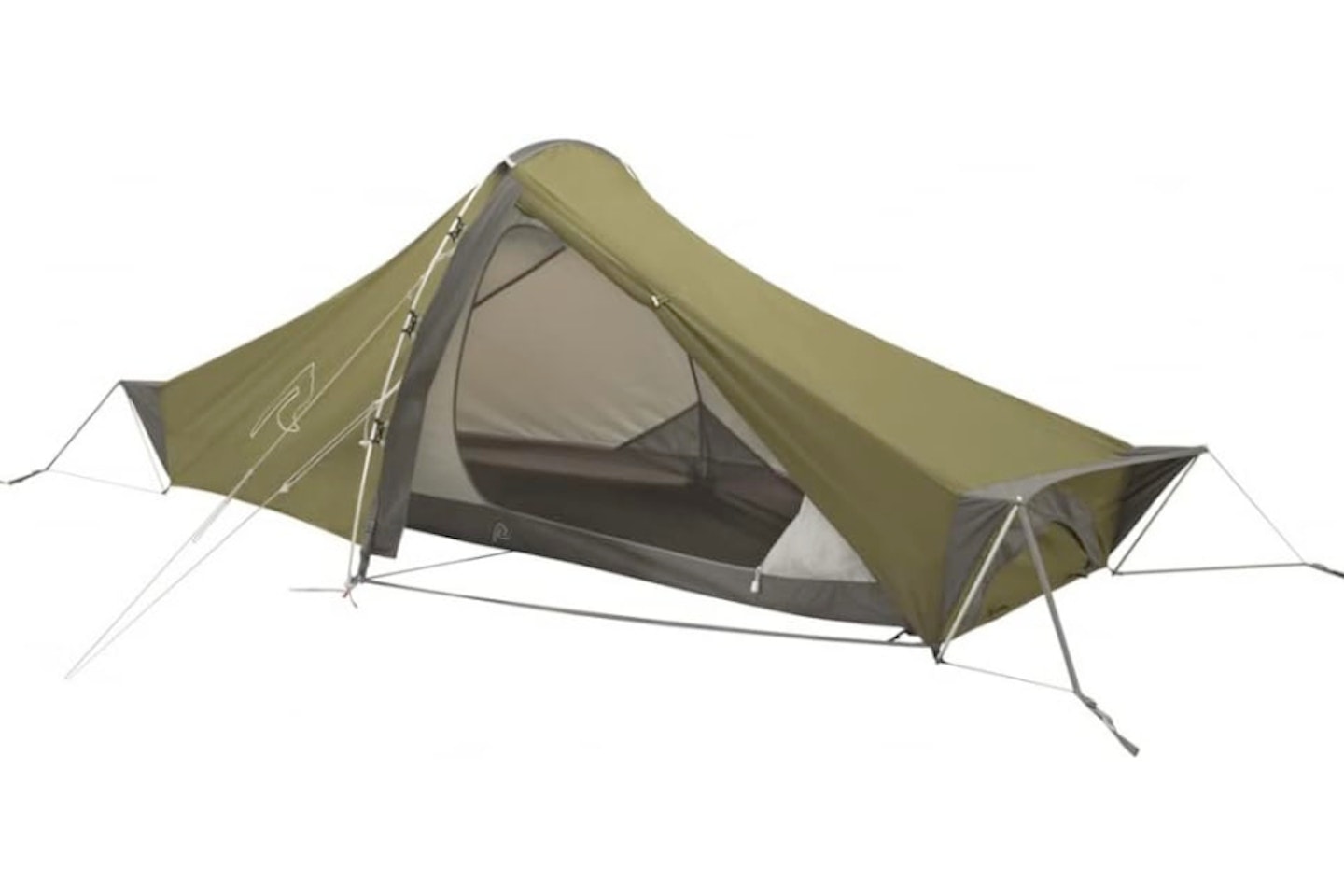
www.outdooraction.co.uk
Robens can be trusted to deliver reliable camping equipment, and the Starlight 1 is a prime example of this eye for quality. Robust and well-defended against water and wind, the Roben Starlight 1 is one of the best tents for wild camping because it's trustworthy - which means a lot when you're miles from civilisation and the weather turns.
With a 5,000HH flysheet, it's the most waterproof tent offering we recommend. Additionally, the tent has been designed and tested with storm winds in mind, withstanding, on average, 100 mph winds. In no small part, this strength is earned from the Storm Guards System - a fabric connection between the flysheet, pole, and guylines which provides stability and minimises stress by spreading the strain created by severe winds.
It's a nice tent to pitch with clip-on pole catches and short corner poles, even in a rush. Once erected, you'll have plenty of headroom to sit up and operate inside the tent. There's a porch for storing a few small bits outside, too.
The only downside of this tent will be felt by minimalists trying to save every last gram - it's a 2kg tent. Far from heavy, it is nevertheless the heaviest one-person tent on our list. But it is the toughest.
The Robens Starlight is also available as a two-person tent, the Robens Starlight 2.
Pros
- 5,000HH waterproofing
- Quality storm-proof construction
Cons
- Lighter options available
- Shallow porch
| Total weight: | 2kg |
| Pack size: | 39 x 15 cm |
| Fabric: | <strong>Flysheet:</strong> HydroTex HD RS, 75D polyester 190T, Ripstop <strong>Inner:</strong> 68D polyester 190T, breathable polyester <strong>Floor:</strong> 75D polyester Taffeta 210T PU coated, 10.000 mm |
| HH rating: | 5000mm |
| Capacity: | One person |
| Trail weight: | 1.7kg |
Best tent for wild camping with headroom
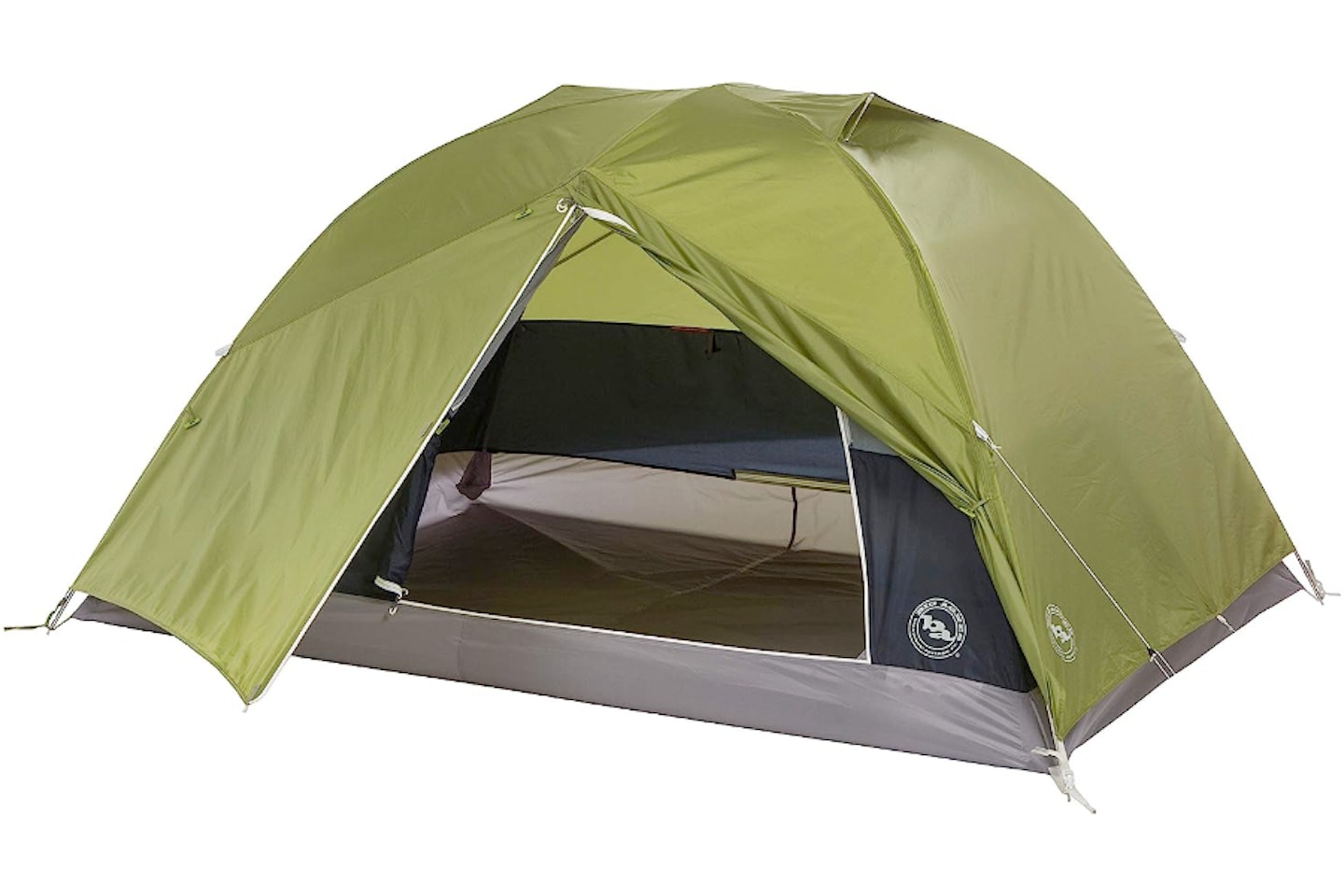
wildbounds.com
If there are two of your wild camping and you want to share a tent, the Big Agnes Backtail 2 is exactly what you need. Offering up a nice square floor area, two entrances, and over 100cm of head height, there's plenty of room for manoeuvrability. Most impressive of all is that Big Agnes has made this happen without cranking up the weight - at 2.24kg packed, it's a more than manageable load.
In part, the weight saving has been achieved with a slight compromise on the material's durability. With a 1,500HH, this isn't the best tent to have in torrential rains and storms. However, for wild camping summer and spring weather, this isn't going to be too much of an issue.
Pros
- Light for a two-man
- Spacious
Cons
- Lower HH rating than some
| Total weight: | 2.24kg |
| Pack size: | 53 x 18 cm |
| Fabric: | Polyester |
| HH rating: | 1500 |
| Capacity: | Two person |
| Trail weight: | 2.04kg |
Best hammock tent for wild camping
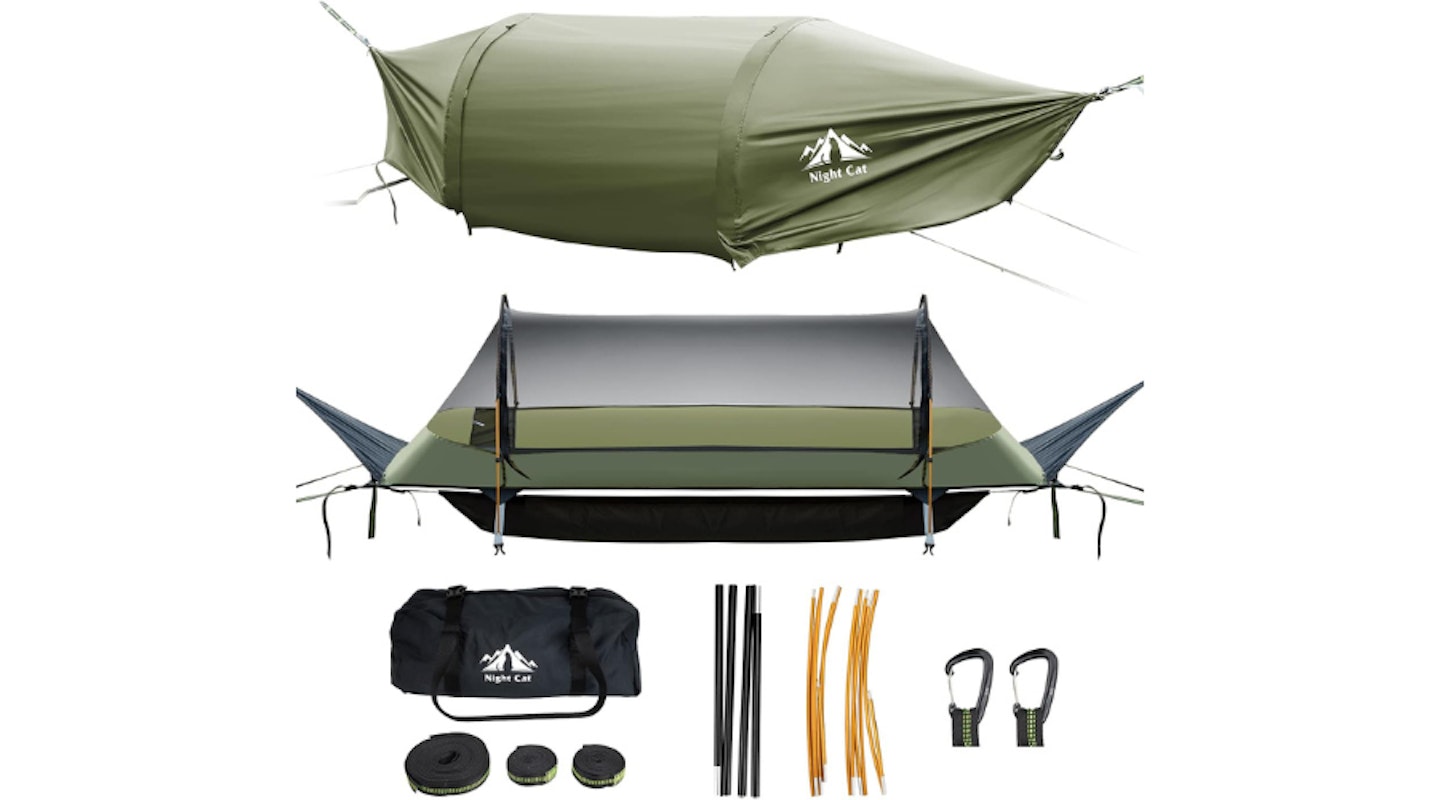 Amazon
AmazonThe Night Cat Flat Lay Hammock Tent is the perfect companion for the solo adventurer looking for a convenient and comfortable wild camping tent. This hammock tent boasts a robust mosquito net to keep the bugs at bay, ensuring a peaceful night's sleep suspended above the ground. It comes in a stealthy dark green, blending into natural surroundings, providing not just security but also a touch of camouflage.
Spot the integrated rainfly, which provides excellent waterproofing capabilities, so it's suitable for those unexpected downpours. The rainfly also offers additional storage space under its shelter, great for keeping gear dry and within reach. With its flat lay design, the Night Cat ensures a more stable and comfortable sleeping position compared to traditional hammock curves.
Despite the vast features, the Night Cat remains impressively lightweight and easy to pack, making it a superb choice for backpackers who prioritize both protection and portability. Whether you're setting up camp by a serene lake or in a dense forest, this hammock tent ensures a delightful, hassle-free wilderness sleeping experience.
Pros
- Smart hammock design
- Full of features
- Totally waterproof
Cons
- Quite creaky when entering and leaving
| Total weight: | 3.5kg |
| Pack size: | 220 x 70 cm |
| Fabric: | Polyester |
| HH rating: | 4000 |
| Capacity: | One person |
| Trail weight: | - |
10.
MSR Access 1
Best tent for winter wild-camping
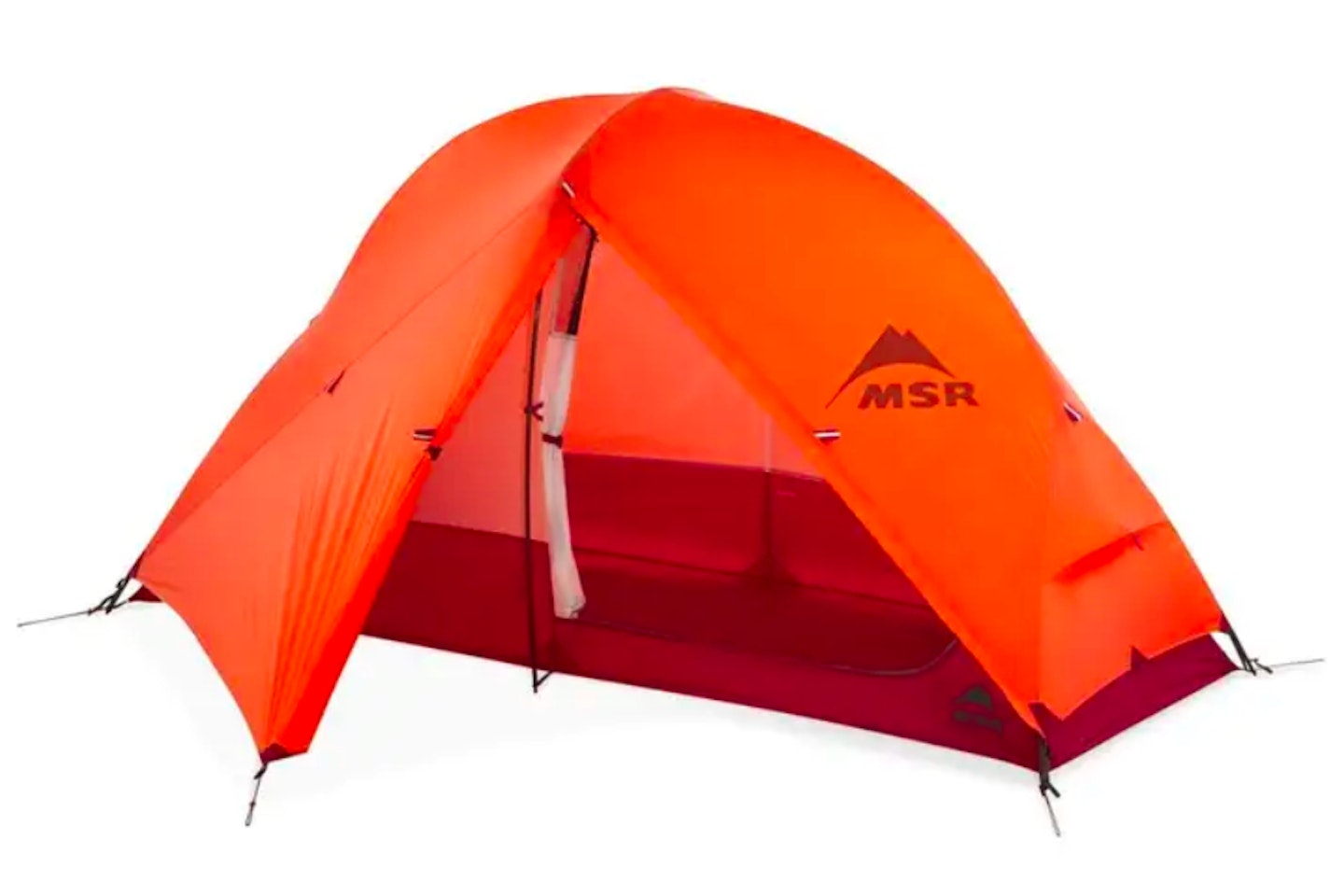
Camping in winter is a tall order at the best of times. But add the requirements of wild camping into the mix, and your tent options shrink considerably. Thanks to MSR, this doesn't matter because the only tent you need to consider is the Access.
As light as a standard wild camping tent, this mountaineering tent offers a warm and dry haven from the harshest winter weather - snow, wild and driving rain. The inner tent has only a few panels of mesh for breathability - the rest is solid to trap in warmth and keep out the cold. Its geodesic pole setup is strong in severe winds. The flysheet only has a HH of 1,200, which would usually raise an eyebrow, but the MSR Xtreme Shield coating means it's a dry place to sleep.
The only slight downside to the Access is that the inner needs erecting first - not ideal if it's raining. However, with practice, the pitching is quick and straightforward, so the worst can be avoided.
The MSR Access is also available as a two-person tent, the MSR Access 2.
Pros
- Excellent winter tent
- Great weather protection
- Robust construction
Cons
- Expensive for non-winter use
| Total weight: | 1.6kg |
| Pack size: | 46 x 15 cm |
| Fabric: | 20D ripstop nylon 1200mm Xtreme Shield™ polyurethane & silicone |
| HH rating: | 1200 |
| Capacity: | One person |
| Trail weight: | 1.37kg |
How to choose the best wild camping tent
When choosing a tent for wild camping, you must ensure that it meets your needs and withstands the challenges of outdoor conditions. Here are some key features to look for in a wild camping tent:
Durability: Look for a tent made from sturdy and high-quality materials that can withstand rough terrain, strong winds, rain, and potential abrasions from rocks or branches. Ripstop nylon or polyester fabrics are used for their strength and resistance to tearing.
Weather resistance: Opt for a tent designed to handle various weather conditions. Look for features like an excellent HH-rated flysheet, taped seams, and a waterproof or highly water-resistant floor. Consider the tent's hydrostatic head rating, which indicates its water resistance level - higher is better.
Weight and pack size: Wild camping often involves hiking with your gear for days, or even weeks, at a time, so choose a tent that is lightweight and compact when packed. Look for materials and designs that prioritise minimising weight without compromising durability.
Size and capacity: Consider the tent's size based on the number of occupants and the gear you plan to store inside. Remember that wild camping tents prioritise weight reduction so that they may be more compact than typical camping tents. Ensure it provides enough space for a comfortable sleep.
Setup: Look for a tent that is easy and quick to set up.
Ventilation: Proper ventilation reduces condensation buildup and maintains a comfortable sleeping environment. Look for tents with mesh panels airflow while keeping insects out. Adjustable vents on the rainfly are also helpful.
Strength and stability: Wild camping often means dealing with unpredictable weather conditions. Choose a tent with a sturdy frame, reliable pole system and guy lines. This will ensure stability and prevent your tent from collapsing in high winds. We'd also recommend buying upgraded tent pegs to ensure your tent is well anchored.
Additional features: Consider other elements that might enhance your camping experiences, such as a porch for gear storage, multiple doors for easy access, interior pockets for organising smaller items, and a footprint or groundsheet to protect the tent's floor from damage and moisture.
Tent HH explained:
HH stands for "Hydrostatic Head". It's a measurement used to determine the waterproofing capability of fabric, including tent materials. It represents the amount of water pressure the fabric can withstand before water penetrates it. The higher the HH rating, the more water-resistant the fabric is.
The HH rating is typically measured in millimetres (mm) and indicates the height of a column of water that the fabric can support before it leaks. For example, a tent with a HH rating of 2,000mm means that the material can withstand a 2,000mm (or 2-metre) column of water without leaking.
• 800mm to 1,500mm: Basic water resistance. Suitable for light rain and mild weather conditions. It may not be sufficient for heavy or prolonged rainfall.
• 1,500mm to 2,500mm: Good water resistance. Provides reliable protection against moderate rain showers and average weather conditions.
• 2,500mm to 4,000mm: Excellent water resistance. Suitable for heavy rain and more challenging weather conditions. It offers increased protection and reliability.
• 4,000mm and above: Excellent water resistance. Ideal for extreme weather conditions, including heavy downpours and prolonged rainfall. Provides a high level of protection against water penetration.
It's important to note that the HH rating is not the only factor that determines a tent's waterproofing capability. Other factors, such as material treatments, seam sealing, quality of zippers, and design features, also contribute to the overall water resistance of a tent.
When choosing a tent, consider the typical weather conditions you may encounter during your camping trips. A higher HH rating is generally recommended for wild camping or camping in areas prone to heavy rainfall. However, keep in mind that higher HH ratings may also result in slightly heavier tent fabrics.
To ensure you are using the HH rating fully, you must set up your tent to maximise its waterproofing performance properly.

Guidelines for wild camping
These are the wild camping guidelines for Scotland, but they are good rules to follow whenever wild camping.
• Camp in small numbers.
• Do not camp in enclosed fields of livestock or crops.
• Camp away from buildings, roads and historic structures.
• Take your litter with you.
• Use a stove rather than a fire where possible.
• Check advice on fire risk conditions.
• Keep fires small, controlled and supervised.
• Bury human waste and urinate 30 metres away from open water.
• Remove all traces of your tent pitch – including any campfire debris.
Wild camping: Leave no trace
There are seven principles to abide by when wild camping. These ensure that you and others can continue to enjoy the wonder of wild camping while minimising your impact on the natural world.
You can read more about the principles on the Leave No Trace site, but here are the seven principles:
• Plan and prepare.
• Travel and camp on durable surfaces.
• Dispose of waste properly.
• Leave what you find.
• Minimise campfire impacts.
• Respect wildlife.
• Be considerate of others.
Wild camping: Top tips from the experts
Wild camping is a joy, but it can be a nightmare without proper planning and equipment. We asked the experts of Live For The Outdoors for some advice when it comes to wild camping. Here is what they told us:
Safety
• Always carry a map, compass, GPS device, mobile phone, headtorch and first aid kit.
• Let someone know your approximate route, where you'll camp, and when you'll be home. In an emergency, they can provide information to Mountain Rescue.
Pitching
• Flat, soft and dry grass is best.
• Avoid rocks and puddles of water.
• Clear your ground of sticks and debris as best as possible.
• In doubt that you've chosen a good spot? Lay down on the floor to test the site before pitching.
Windy weather?
• Find shelter from the wind if the weather is kicking up a gale.
• A lee of a hill, behind a crag or a wall works well. Just note that if you use a wall, don't pitch right against it in case it should topple - and ensure you are on the unenclosed side.
• Pitch the lowest and narrowest part of your tent into the wind. That way, the wind sweeps over rather than smashing into its side.
• Use guy ropes and pitch securely.

Is it legal to wild camp in England and Wales?
In general, it is illegal to wild camp in England and Wales without landowner permission.
Previously, Dartmoor was the only location that allowed wild camping, but there have been legal disputes over this process. For now, you can wild camp in Dartmoor if you meet specific requirements that align with a "new permissive system". You can read more about this on the Dartmoor National Park website.
While it is illegal to wild camp in England, that doesn't mean it doesn't happen. For example, as pointed out by UK Outdoors, The Lake District is tolerant of wild campers and has guidance for them to follow - basically, one tent can stay up high in the fells so long as they don't get in the way and don't leave a mess. Similarly, seeing people wild camping in other National Parks is not unusual.
What is the punishment for illegally wild camping?
The punishment for wild camping without permission is getting asked to move on from the location. Wild camping without permission is considered trespassing and is, therefore, a civil offence, meaning you cannot get arrested for wild camping.
Fines and stricter punishments are reserved for those repeatedly offending, damaging property, or becoming an issue in other ways. In the vast majority of circumstances, people are asked to move on. So long as they do so, there's nothing more to the matter.
Is wild camping legal in Scotland?
Yes, generally, it is legal to wild camp in Scotland thanks to the Land Reform Act (2003), the act of the Scottish parliament that secures public access rights for unenclosed land in Scotland.
Note that a bylaw is in place for Loch Lomond and the Trossachs, which requires a permit for the most popular spots between March and September.
You must abide by the Outdoor Access Code when wild camping in Scotland.
Should you use a two-person tent when wild camping?
So long as you can carry the tent, there's no reason that a two-person tent is unsuitable for wild camping. But you want to ensure you get on well with your roommate - it will be a cosy squeeze. Plus, you lose the benefit of being able to pitch up far away from your hiking buddy, especially if they are a snorer.
There are a few things to consider when wild camping with a two-person tent. The ground space needed to pitch a two-person tent is double that of a one-person, meaning you must locate a larger, flat area free from lumps and bumps.
The tent will also be heavier than a one-person tent. If you're on a multi-day hike, you can always do a daily rotation taking the tent to even the load.
Can I use any regular tent for wild camping?
While you can use a regular tent for wild camping, tents designed explicitly for wild camping are more suitable. They are typically lighter, more durable, and better equipped to handle the challenges of outdoor conditions.
How many seasons should a wild camping tent be suitable for?
Wild camping tents tend to come in two types: three-season or four-season. Three-season tents are suitable for spring, summer, and autumn. Four-season tents can handle winter conditions, including snow and high winds.
Can I use a wild camping tent for other types of camping?
Yes, wild camping tents are suitable for other types of camping, such as backpacking, bikepacking, hiking, or campsite trips. However, remember that they are designed with specific features to cater to the needs of wild camping.
If you like camping, we recommend having two tents - one that's lightweight and designed for wild camping and a second, larger option that provides more comfort and space for campsites - for example, a three-person tent.
Can I camp in extreme weather conditions with a wild camping tent?
Four-season wild camping tents handle extreme weather conditions, including heavy snow, high winds, and colder temperatures. However, choosing a tent that matches the specific weather conditions you expect to encounter during your adventures is essential.
Unless you are a seasoned wild camper and experienced with life outdoors, we do not recommend voluntarily wild camping in extreme weather. Always check the forecast, and plan and adjust these plans accordingly.
How should I clean and maintain my wild camping tent?
Use a specialised tent cleaner and a soft sponge or cloth to clean your tent. Avoid harsh chemicals or machine washing, which can strip away essential coatings and damage durability. After cleaning, ensure the tent is completely dry before packing it away to prevent mildew or damage. Store it in a cool, dry place when not in use.
Can I repair my wild camping tent if it gets damaged?
Yes, many wild camping tents come with repair kits or patches for minor repairs. You can also purchase specialised tent repair tape or adhesive to fix small tears or holes. For more extensive damage, contacting the manufacturer or a professional gear repair service is recommended.
We recommend carrying a small repair kit of essentials, such as tent glue, to do any minor fixes on-site and have an enjoyable camping experience.
William Lobley is the Editor for What's The Best. Here, he oversees, curates and researches listicles and reviews as many products as his home office can handle.
He has spent nearly five years writing about tech, audio, outdoors and fitness and has reviewed everything from smartphones to ice baths. In addition, he's well-versed in sniffing out the best deals and savings the internet offers.
When not at his desk writing, reviewing or deal-hunting, he'll be relaxing with Japanese crime novels, bingeing some classic anime, strolling the countryside or at the gym listening to the heaviest metal Spotify has to offer.
Subscribe to the What’s The Best Newsletter to keep up to date with more of the latest reviews and recommendations from Will and the rest of the What’s The Best team.
